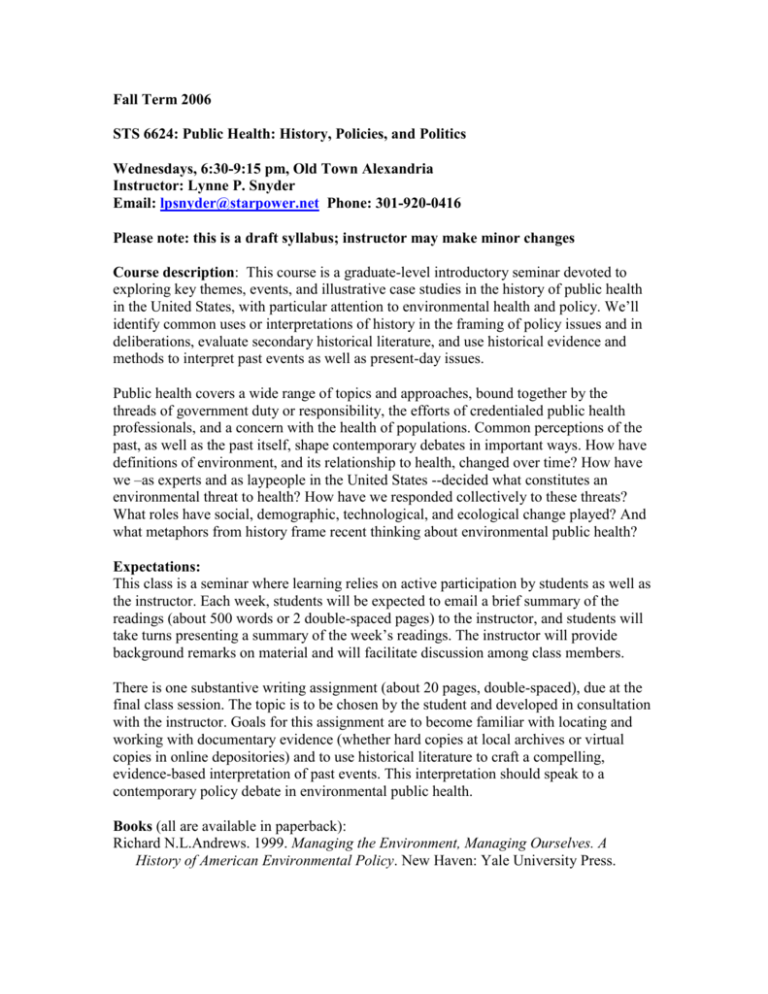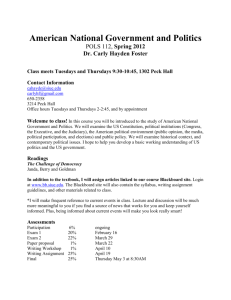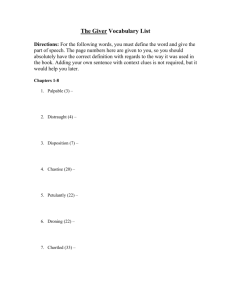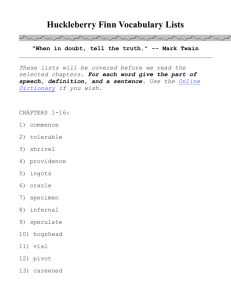Public Health: History, Policies, and Politics
advertisement

Fall Term 2006 STS 6624: Public Health: History, Policies, and Politics Wednesdays, 6:30-9:15 pm, Old Town Alexandria Instructor: Lynne P. Snyder Email: lpsnyder@starpower.net Phone: 301-920-0416 Please note: this is a draft syllabus; instructor may make minor changes Course description: This course is a graduate-level introductory seminar devoted to exploring key themes, events, and illustrative case studies in the history of public health in the United States, with particular attention to environmental health and policy. We’ll identify common uses or interpretations of history in the framing of policy issues and in deliberations, evaluate secondary historical literature, and use historical evidence and methods to interpret past events as well as present-day issues. Public health covers a wide range of topics and approaches, bound together by the threads of government duty or responsibility, the efforts of credentialed public health professionals, and a concern with the health of populations. Common perceptions of the past, as well as the past itself, shape contemporary debates in important ways. How have definitions of environment, and its relationship to health, changed over time? How have we –as experts and as laypeople in the United States --decided what constitutes an environmental threat to health? How have we responded collectively to these threats? What roles have social, demographic, technological, and ecological change played? And what metaphors from history frame recent thinking about environmental public health? Expectations: This class is a seminar where learning relies on active participation by students as well as the instructor. Each week, students will be expected to email a brief summary of the readings (about 500 words or 2 double-spaced pages) to the instructor, and students will take turns presenting a summary of the week’s readings. The instructor will provide background remarks on material and will facilitate discussion among class members. There is one substantive writing assignment (about 20 pages, double-spaced), due at the final class session. The topic is to be chosen by the student and developed in consultation with the instructor. Goals for this assignment are to become familiar with locating and working with documentary evidence (whether hard copies at local archives or virtual copies in online depositories) and to use historical literature to craft a compelling, evidence-based interpretation of past events. This interpretation should speak to a contemporary policy debate in environmental public health. Books (all are available in paperback): Richard N.L.Andrews. 1999. Managing the Environment, Managing Ourselves. A History of American Environmental Policy. New Haven: Yale University Press. STS 6624: Public Health: History, Policies, and Politics page 2 of 7 John Duffy. 1990. The Sanitarians: A History of American Public Health. Urbana and Chicago: University of Illinois Press. Margaret Humphreys. 1992. Yellow Fever and the South. Baltimore: Johns Hopkins University Press. Eric Klinenberg. 2002. Heat Wave. A Social Autopsy of Disaster in Chicago. Chicago: University of Chicago Press. Alan M. Kraut. 2004. Goldberger’s War: The Life and Work of a Public Health Crusader. Boston: Hill & Wang. Gerald Markowitz and David Rosner. 2003 (c.2002). Deceit and Denial. The Deadly Politics of Industrial Pollution. Berkeley: University of California Press/The Milbank Memorial Fund. Charles E. Rosenberg. Revised edition, 1987 (c.1962). The Cholera Years. The United States in 1832, 1849, and 1866. Nancy Tomes. 1999. The Gospel of Germs: Men, Women, and the Microbe in American Life, 1870-1930. Cambridge: Harvard University Press. Introduction 1.thinking historically about links between public health and environmental policy Elizabeth Fee. “The Origins and Development of Public Health in the United States.” Pp. 35-54 in Oxford Textbook of Public Health, 3rd edition. Eds. Roger Detels, Walter Holland, James McEwen and Gilbert S. Omenn. Oxford: Oxford University Press, 1997. Fitzhugh Mullan. “Public Health Then and Now. Don Quixote, Machiavelli, and Robin Hood: Public Health Practice, Past and Present.” American Journal of Public Health 90#5 (May 2000): 702-706. Richard E. Neustadt and Ernest R. May. “What to Do and How: A Summary.” Chapter 13 (pp. 232-246) and “Seeing Time as a Stream.” Chapter 14 (pp. 247-270) in Thinking In Time. The Uses of History for Decision Makers. New York: The Free Press, 1986. John L. Parascandola. “Public Health Service.” Pp.487-493 in ed. George T. Kurian. A Historical Guide to the U.S. Government. New York: Oxford University Press, 1998. Joel A. Tarr, “The Search for the Ultimate Sink: Urban Air, Land, and Water Pollution in Historical Perspective,” chapter 1 (pp.7-35) in The Search for the Ultimate Sink. Urban Pollution in Historical Perspective. Akron: University of Akron Press, 1996. 2. library/archives session (during business hours) Antebellum America: plagues, settlement, and the land 3. 1760s-1800s: yellow fever, quarantine, and the origins of federal public health STS 6624: Public Health: History, Policies, and Politics page 3 of 7 Andrews. “Colonial Precedents: Environment as Property,” Chapter 3 (pp.28-50); “The Constitutional Framework,” Chapter 4 (pp.51-70); and “Land and Transport: Commercial Development as Environmental Policy,” Chapter 5 (pp.71-93) in Managing the Environment, Managing Ourselves Duffy, “The Years of Growth and Expansion,” Chapter 2 (pp.20-34) and “The Appearance of Health Boards,” Chapter 3 (pp. 35-51) in The Sanitarians Martin S. Pernick. “Politics, Parties, and Pestilence: Epidemic Yellow Fever in Philadelphia and the Rise of the First Party System.” Chapter 25, pp. 356-371 in Leavitt and Numbers, Sickness and Health. 4.1810s through 1850s: seeking health through urban sanitation and westward migration Rosenberg. Introduction and Chapters 1-9 (pp.1-174) in The Cholera Years. Duffy. “The Early Sanitary Movement.” Chapter 5 (pp.66-78); and “The Sanitary Reformers.” Chapter 7 (pp. 93-109). Linda Nash. “Finishing Nature: Harmonizing Bodies and Environments in LateNineteenth Century California.” Environmental History 8#1 (January 2003): 25-52. Conevery Bolton Valencius. “Gender and the Economy of Health on the Santa Fe Trail.” Landscapes of Exposure. Knowledge and Illness in Modern Environments. Osiris 19 (2004 ): 79-92 5. the Civil War and the 19th century South: transforming public health from a regional to a national concern Rosenberg. Chapters 10-13 (pp.175-234). Humphreys. Introduction, Chapters 1 and 2 (pp. 1-76) in Yellow Fever and the South. Duffy. “Public Health and the Civil War.” Chapter 8 (pp. 110-125). Suellen Hoy. “A Wider War.” Chapter 2 (pp. 29-58) in Chasing Dirt: The American Pursuit of Cleanliness. New York: Oxford University Press, 1995. Post-Civil War to World War Two: public health on a national scale 6. the Progressive Era, part 1 (1870s-1900s): urban sanitation meets germ theory Andrews. “Public Health and Urban Sanitation.” Chapter 7 (pp. 108-135). Gretchen A. Condran, Henry Williams, and Rose A. Cheney. “The Decline in Mortality in Philadelphia From 1870 to 1930: The Role of Municipal Services,” chapter 30 (pp.422-436) in Leavitt and Numbers, Sickness and Health in America. Readings in the History of Medicine and Public Health. Madison, WI: University of Wisconsin Press, c1985. STS 6624: Public Health: History, Policies, and Politics page 4 of 7 Duffy. “Hospitals and the Federal Government’s Role in Public Health.” Chapter 11 (pp.157-174). Humphreys. Chapters 3-5 (pp.77-178). Tomes. Chapters 1-6 (pp.23-154) in The Gospel of Germs. 7. the Progressive era, part 2 (1900s –1920s): immigrants and experts Duffy. “The Federal Government and Health Reform.” Chapter 16 (pp. 239-255). Kraut. Chapters 1-4 (pp. 13-120) in Goldberger’s War. Alan Kraut. “Silent travelers: germs, genes, and American efficiency, 18901924.” Soc Sci Hist 12#4 (winter 1988): 377-393. Judith W. Leavitt. “Typhoid Mary strikes back. Bacteriological theory and practice in early twentieth-century public health.” Isis 83#4 (December 1992): 608-629. Guenter B. Risse. A long pull, a strong pull, and all together: San Francisco and bubonic plague, 1907-1908. Bulletin of the History of Medicine 66#2 (Summer 1992): 260-289. Christopher Sellers.“Factory as Environment: Industrial Hygiene, Professional Collaboration and the Modern Sciences of Pollution.” Environmental History Review 18 #1 (Spring 1994): 55-84. John P. Swann "Food and Drug Administration." In A Historical Guide to the U. S. Government, George Thomas Kurian, ed., pp. 248-254. New York: Oxford University Press, 1998. Tomes. Chapters 7-9 (pp.157-233). 8. 1930s-1940s: federal responses to environmental and health crises Andrews. “Progressivism: Conservation in the Public Interest.” Chapter 8 (pp. 136-153); and “Administering the Environment: Subgovernments and Stakeholders.” Chapter 9 (pp.154-178). Allan M. Brandt. “Racism and Research: The Case of the Tuskegee Syphilis Experiment.” The Hastings Center Report 8 (December 1978): 21-29. Duffy. “The Great Depression and the War Years.” Chapter 17 (pp.256-272) Michael R. Grey, “Puttin’ Out for the Farmers. The Evolution of New Deal Rural Rehabilitation Policy,” chapter 1 (pp.20-47) in New Deal Medicine. The Rural Health Programs of the Farm Security Administration. Baltimore: Johns Hopkins, 1999. Margaret Humphreys. “Water won't run uphill: the New Deal and malaria control in the American South, 1933-1940.” Parassitologia 40#1-2 (June 1998): 183191. Kraut. Chapters 5-9 (pp. 121-256). Joel A. Tarr, “Industrial Wastes, Water Pollution, and Public Health, 1876-1962,” chapter 14 (pp.354-384) in The Search for the Ultimate Sink. Urban Pollution in Historical Perspective. Akron: University of Akron Press, 1996. STS 6624: Public Health: History, Policies, and Politics page 5 of 7 Paper proposals due Environmental public health since World War Two: 9. a new wave of environmentalism Andrews. “The Rise of Modern Environmentalism.” Chapter 11 (pp. 201-226) Duffy. “The Postwar Years.” Chapter 18 (pp. 273-293). Samuel P. Hays. “The Environmental Impulse.” Chapter 3 (pp.22-35) in A History of Environmental Politics Since 1945. Pittsburgh: University of Pittsburgh Press, 2000. 10. revisiting old issues: air, water, land, occupational health Craig E. Colten and Peter N. Skinner. “Recognizing Dangers.” Chapter 2 (pp.1245) in The Road to Love Canal. Managing Industrial Waste before EPA. Austin: University of Texas Press, 1996. David Lilienfeld. “The silence: the asbestos industry and early occupational cancer research –a case study.” American Journal of Public Health 81#6 (June 1991): 791-800. Gerald Markowitz & David Rosner. Chapters 1 through 4 (pp. 12-138) in Deceit and Denial. Adam Rome, “Septic-Tank Surburbia: The Problem of Waste Disposal at the Metropolitan Fringe,” chapter 3 (pp.87-118) in The Bulldozer in the Countryside. Suburban Sprawl and the Rise of American Environmentalism. New York: Cambridge Univ. Press, 2001. Lynne P. Snyder. “Revisiting Donora, Pennsylvania’s 1948 Air Pollution Disaster.” Pp.126-144. In Joel Tarr, ed. Devastation and Renewal. An Environmental History of Pittsburgh and Its Region (Pittsburgh University Press, 2003). 10. new issues: pesticides, plastics, cancer, fluoridation, cigarettes, and the bomb Paul Boyer. “The American Medical Profession and the Threat of Nuclear War.” Chapter 5 (pp.61-86) in Fallout. A Historian Reflects on America’s HalfCentury Encounter with Nuclear Weapons. Columbus: Ohio State University Press, 1998. Doug Brugge and Rob Goble, “Public Health Then and Now: The History of Uranium Mining and the Navaho People,” American Journal of Public Health 92#9 (September 2002): 1410-1419. Elizabeth W. Etheridge, chapters 1 (War and the Mosquito) through 5 (Establishing Credibility), pp. 1-86 in Sentinel for Health. A History of the Centers for Disease Control. Berkeley and Los Angeles: Univ California Press. Markowitz and Rosner. “Better Living Through Chemistry.” Chapter 5 (pp.139167). STS 6624: Public Health: History, Policies, and Politics page 6 of 7 Mark Parascandola. “Public Health Then and Now. Cigarettes and the US Public Health Service in the 1950s.” American Journal of Public Health 91#2 (February 2001): 196-205. Robert Proctor. “The Environmentalist Thesis.” Pp. 35-53. In Cancer Wars. How Politics Shapes What We Know & Don’t Know About Cancer (Basic Books, 1995). Edmund Russell, “War comes home (1945-1950),” chapter 9 (pp.165-183) and “Backfires (1958-1963),” chapter 11 (pp.204-228) in War and Nature. Fighting Humans and Insects with Chemicals from World War I to Silent Spring. New York: Cambridge Univ. Press, 2001. 12. the era of the Environmental Protection Agency (EPA), part 1 (1970s-1990s): new federal agencies, enduring priorities Andrews. “Nationalizing Pollution Control.” Chapter 12 (pp. 227-254); and “Reform or Reaction? The Politics of the Pendulum.” Chapter 13 (pp. 255283) Markowitz and Rosner. Chapters 6-10 (pp.168-298). Edmund Russell. “Lost Among the Parts Per Billion: Ecological Protection at the United States Environmental Protection Agency, 1970-1993.” Environmental History 2#1 (January 1997): 29-51. 12. the EPA era, part 2 (1990s): redefining public health and environment Eric Klinenberg. Heat Wave. A Social Autopsy of Disaster in Chicago. Chicago: University of Chicago Press, 2002. Christopher H. Forman, Jr. “Foundations.” Chapter 2 (pp. 9-33) in The Promise and Peril of Environmental Justice. Washington, DC: The Brookings Institution Press, 1998. Andrew Hurley. “Fiasco at Wagner Electric: Environmental Justice and Urban Geography in St. Louis.” Environmental History 2#4 (October 1997): 460481. 13. historical evidence in the courtroom: revisiting the past Vinyl chloride http://www.deceitanddenial.org. Legal brief written by Philip Scranton [Scranton.pdf] Response written by David Rosner and Gerald Markowitz [Response_To_Scranton.pdf] Lead John C. Burnham. “Forum: ‘The Unbearable Heaviness of Lead.’ Comment.” Bulletin of the History of Medicine 78 (2004): 196-200. STS 6624: Public Health: History, Policies, and Politics page 7 of 7 Christopher Sellers. “[book review] Christian Warren. Brush With Death. A Social History of Lead Poisoning.” Bulletin of the History of Medicine 75 (2001): 823-825. Ellen Silbergeld. “Essay Review. The Unbearable Heaviness of Lead.” Bulletin of the History of Medicine 77 (2003): 164-171; “’Author’s Response.” Bulletin of the History of Medicine 78 (2004): 198-199. Christian Warren. “[book review] Gerald Markowitz and David Rosner. Deceit and Denial.” Bulletin of the History of Medicine 78 (2004): 507-509. Course wrapup and student presentations 14. contemporary history: where we find ourselves now, in the stream of time Andrews. “The Unfinished Business of National Environmental Policy.” Chapter 14 (pp. 284-318); and “Environmental Policy in a Global Economy.” Chapter 15 (pp. 319-351) Committee on Assuring the Health of the Public in the 21st Century. “Understanding Population Health and Its Determinants.” Pp. 46-95. In Institute of Medicine. The Future of the Public’s Health in the 21st Century (National Academies Press, 2003). U.S. Department of Health and Human Services. Environmental Health. Chapter 8 (pp.1-40) in Healthy People 2010: Objectives for Improving Health (Washington, DC: USGPO, 2000). 15. student presentations; paper due






